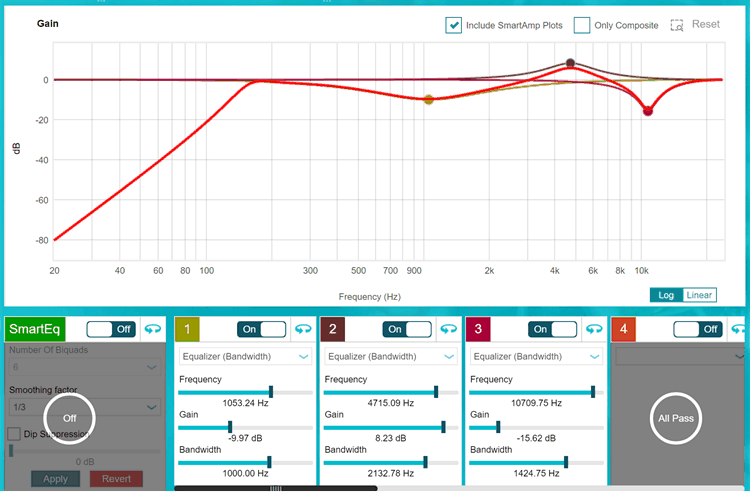SLAA936A September 2020 – March 2021 TAS2563
- Trademarks
- 1Introduction
-
2Quick Tuning Procedure
- 2.1 Initialize Tuning
- 2.2 Flatten Protection
- 2.3 Frequency Response Matching
- 2.4 Microphone Setup
- 2.5 Record Reference Device Response
- 2.6 Set Input Gain
- 2.7 Equalizer
- 2.8 Dynamic Range Compression (DRC)
- 2.9 Smart Amp Protection
- 2.10 Speaker Protection Verification
- 2.11 System Signal Chain
- 2.12 Tuning Elements
- 2.13 PDM MIC
- 3Related Documentation
- 4Revision History
2.7 Equalizer
The next step is to use the smart amp equalizer to match the shape of the curve across the spectrum as much as possible. The most common biquad to use for adjusting the EQ is the “Equalizer (Bandwidth) or Equalizer (Q Factor)”, which functions as a band-pass filter where the center frequency, gain, and width can be adjusted. Adjustments to the bass shelf, treble shelf, and low-pass filter can also be useful. Continue to play the –48-dB pink noise on the target device and overlap the target device response and the reference device response as before. Use the available biquads to match the target response to the reference response as best possible.
Figure 2-3 shows an overview of the equalizer tool. Figure 2-4 shows an example of low-volume pink noise matching.
 Figure 2-3 Equalizer Overview
Figure 2-3 Equalizer Overview Figure 2-4 Pink Noise Low-Volume Matching
Figure 2-4 Pink Noise Low-Volume MatchingAfter completing this step, record the target device response for the –48-dB pink noise as well as –78 dB through –24 dB. If the –48-dB target device response matches the reference response, then the remaining plots up to –24 dB are likely to match as well. This occurrence is known as low-volume response, or low- volume tuning, which is not affected by any DRC or speaker protection, but only the input gain and EQ.